Ronnie Peterson
Bengt Ronnie Peterson (Swedish pronunciation: [ˈrɔ̌nːɪ ˈpêtːɛˌʂɔn]; 14 February 1944 – 11 September 1978) was a Swedish racing driver. Known by the nickname 'SuperSwede',[1][2] he was a two-time runner-up in the Formula One World Drivers' Championship.
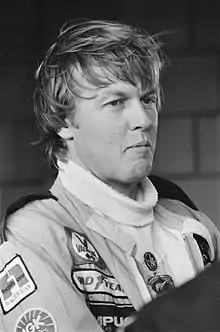 Peterson at the Dutch Grand Prix in August 1978 | |
| Born | 14 February 1944 Örebro, Sweden |
|---|---|
| Died | 11 September 1978 (aged 34) Milan, Italy |
| Formula One World Championship career | |
| Nationality | |
| Active years | 1970–1978 |
| Teams | March inc. non-works, Tyrrell, Lotus |
| Entries | 123 |
| Championships | 0 |
| Wins | 10 |
| Podiums | 26 |
| Career points | 206 |
| Pole positions | 14 |
| Fastest laps | 9 |
| First entry | 1970 Monaco Grand Prix |
| First win | 1973 French Grand Prix |
| Last win | 1978 Austrian Grand Prix |
| Last entry | 1978 Italian Grand Prix |
Peterson began his motor racing career in kart racing, traditionally the discipline where the majority of race drivers begin their careers in open-wheel racing. After winning a number of karting titles, including two Swedish titles in 1963 and 1964, he moved on to Formula Three, where he won the Monaco Grand Prix Formula Three support race for the 1969 Grand Prix. Later that year he won the FIA European Formula 3 Championship and moved up into Formula One, racing for the March factory team. In his three-year spell with the team, he took six podiums, most of which were scored during the 1971 Formula One season in which he also finished as runner-up in the Drivers' Championship.
After seeing out his three-year contract at March, Peterson joined Colin Chapman's Team Lotus in the 1973 season, partnering defending champion Emerson Fittipaldi. During his first two seasons with Lotus, Peterson took seven victories, scoring a career-best 52 points in 1973. After a poor 1975 season, Peterson moved back to March and scored his final victory for the team at the 1976 Italian Grand Prix. After spending the 1977 season with Tyrrell, he moved back to Lotus for the 1978 season as number two driver to Mario Andretti. Peterson scored two wins, at the South African and Austrian Grand Prix races, and finished second in the Drivers' Championship standings despite his fatal first-lap accident at Monza during the Italian Grand Prix.[3]
Early life
Peterson was born in Almby in the vicinity of Örebro, Sweden. He developed his driving style at a young age while competing in karting, and rapidly worked his way up to the pinnacle of European karting before switching to cars.
Formulas Three and Two
After his karting years, Peterson entered Formula Three racing in the Svebe, a 1-litre, Brabham-derived Formula car he co-designed with his father Bengt (who was a baker) and Sven Andersson.
Superb results from the outset quickly attracted the attention of the ambitious Tecno company from Italy, who signed him in 1968. With them, he won the 1969 Formula Three Championship.
Even after his elevation to F1 status Peterson still drove in lower echelon racing series (which was common at the time), winning the 1971 European Formula Two Championship driving for March.
Formula One
Early years


Peterson made his Grand Prix debut in a March 701 for Colin Crabbe's works-supported Antique Automobiles Racing Team at the 1970 Monaco Grand Prix. The limited budget of Crabbe's privateer team allowed only minimal testing, and Peterson qualified 12th out of 16 cars in the race. He was 10 places behind Jackie Stewart and Chris Amon, both on the front row of the grid in their newer specification 701s, but only just behind the more experienced Jo Siffert in the second works March. Peterson was the only March driver to finish the race, in seventh place.[4] In 1971 Peterson moved up to the full March works team, and made an instant impression. Five Formula One Grand Prix second places earned him the position of runner-up to Jackie Stewart in that year's World Championship. Within that year, Peterson drove in the World Sports Car Championship driving an Autodelta Alfa Romeo to win the Watkins Glen 6 hours.[5] Peterson stayed at March until 1973, when he signed for John Player Team Lotus to partner Emerson Fittipaldi.
1973–1976
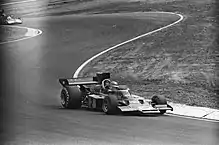
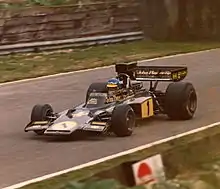
Peterson's first Grand Prix win was at the 1973 French Grand Prix, held at Paul Ricard, in a Lotus 72. He took three more wins that year, in Austria, Italy and the United States, but poor reliability restricted him to only third place in the World Championship at season's end.[6]
For 1974, the Lotus 76 was brought forth. The car, however, proved to be a failure, disliked by both Peterson and his teammate Ickx. The team therefore opted to let them drive the much older Lotus 72:s. Peterson did well in the old car and claimed three more victories: the French and Italian Grands Prix, as well as the Monaco Grand Prix.[2]

1975 was a bad year for Lotus. Peterson and Ickx were forced to drive with the now archaic 72 model, whose age was now really beginning to show.
Peterson had signed for Shadow but Lotus owner Colin Chapman convinced him to stay with Lotus due to a promise Chapman made to accelerate the rate of development on the Lotus 77. He drove the first race of 1976 in the Lotus 77 before rejoining March Engineering. Driving the March 761, he won the Italian Grand Prix.[5]
He also continued to drive sports cars, particularly for BMW in 1974 and 1975. For instance, he was paired with Hans-Joachim Stuck in a BMW 3.0 CSL for the South African "Wynn's 1000" in November 1975, where they started on pole but finished in second after a number of stops with engine vibrations, spark plug, and similar problems.[7] Stuck and Peterson together for BMW in Europe, Africa, and also in North America.
1977: Tyrrell

In 1977, he raced for Tyrrell, driving the six-wheel Tyrrell P34B.[8] Peterson retired from the opening four races of 1977, he spun off in Argentina, was involved in a crash with Jochen Mass's McLaren and Clay Regazzoni's Ensign in Brazil, and suffered fuel systems problems in South Africa and United States West. He finished eight in Spain but retired at Monaco with brake failure. Peterson's only podium finish was a third place at a rain-affected race in Belgium.[8] Hopes were high at home in Sweden but Peterson retired with ignition problems and then finished 12th at France. He had an engine failure in Britain, finished ninth at Germany and got fifth in Austria. Peterson retired with ignition problems at Holland, sixth in Italy and 16th in the United States. Peterson retired from the last two races of 1977, a fuel leak in Canada and in Japan, he collided with Gilles Villeneuve's Ferrari but the crash killed a marshal and photographer as they were standing in a prohibited area of the track when the accident occurred.[9]
1978: Lotus
Peterson surprised many by leaving Tyrrell to return to John Player Team Lotus for 1978.[10] He won the 1978 South African Grand Prix, with a last-lap victory over Patrick Depailler, as well as the Austrian Grand Prix, in the innovative 'ground effect' Lotus 79. His teammate Mario Andretti won the Drivers' Championship with Peterson acting effectively as the Team "No. 2" with the pair scoring four 1–2 wins, all with Andretti at the lead.[10][11][12] Both of Peterson's wins occurred when Andretti encountered trouble, with Andretti winning once when Peterson failed to finish (not including the Italian Grand Prix). Many times, Peterson followed Andretti closely home, leading to speculation that 'Team Orders' were in place.[13]
Throughout the 1970s Peterson had the reputation of being the fastest driver in F1 in terms of raw speed.[14] During the 1978 season Andretti would frequently post the faster qualifying time. Another view, held by some contemporary observers, was that while Peterson may have in fact been the outright quicker of the two, it was Andretti's considerable car development skills that brought the recalcitrant Lotus 78 and 79 to full potential, and Peterson's seeming deference to Andretti was a tacit acknowledgement of this. Despite this, Peterson was offered a seat at McLaren at 1979.[15] Peterson refused to contribute to any controversy, and on numerous occasions dismissed the speculation by stating that Andretti had simply turned the faster time.
Death
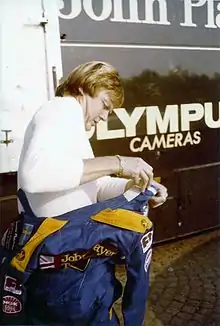
The 1978 Italian Grand Prix at Monza started badly for Peterson. In practice he damaged his Lotus 79 race car beyond immediate repair and bruised his legs in the process. Team Lotus had a spare 79, but it had been built for Andretti, and the taller Peterson did not fit comfortably inside. The team's only other car was a type 78, the previous year's car, which had been dragged around the F1 circuit that season with minimal maintenance.
In the days after the race, many drivers on circuit stated that the race starter lit the green light for the race too early.[16] Although a Formula One start is meant to be a standing start for all cars in the field, the early green light meant that cars in the rear rows were still rolling when the green light came on. This resulted in cars in the back getting a jump on those at the front, and an accordion effect as the cars approached the first chicane, bunching them tightly together. The front four, Andretti, Gilles Villeneuve, Jean-Pierre Jabouille and Niki Lauda, were far enough ahead to avoid any drama, but Peterson had made a poor start from the third row of the grid, and was immediately passed by Alan Jones, Jacques Laffite and John Watson.
Jody Scheckter and Riccardo Patrese, starting 10th and 12th, had moved to the right across the line that separated the Grand Prix front straight from the approach to the old Monza banking. While Scheckter's Wolf was able to rejoin the track well ahead of the bunching pack, Patrese moved back in just ahead of James Hunt, who feinted left and collided with Peterson, with Vittorio Brambilla, Carlos Reutemann, Hans-Joachim Stuck, Patrick Depailler, Didier Pironi, Derek Daly, Clay Regazzoni and Brett Lunger all involved in the ensuing melee.[17]
Peterson's Lotus went into the barriers hard and caught fire before bouncing back into the middle of the track. He was trapped in the burning wreck, but Hunt, Regazzoni and Depailler managed to free him before he received more than minor burns, while track marshals were extinguishing the car. He was dragged free and laid in the middle of the track fully conscious, but with severe leg injuries. Hunt later said he stopped Peterson from looking at his legs to spare him further distress.
At the time there was more concern for Brambilla, who had been hit on the head by a flying wheel and was slumped comatose in his car. Brambilla was seriously hurt and did not race again in Formula One until a year later. Peterson's life was not seen to be in any danger. Sid Watkins and his medical team headed over to Brambilla's car to extract him from the wreckage. The injured drivers along with Peterson were taken to a hospital in Milan and the race was restarted when the track had been cleaned up.[18]
At the hospital, Peterson's X-rays showed he had about 27 fractures in his legs and feet. After discussion with him, Peterson was sent to intensive care so that the surgeons could operate to stabilize the bones.[19] There was some level of dispute between the doctors regarding whether all fractures should be immediately fixed or not.[20] During the night, Peterson's condition worsened, and he was diagnosed with fat embolism.[21] By morning he was in full kidney failure due to the embolism, and was declared dead at 9:55 am on 11 September 1978.[18][21][22]
His teammate Mario Andretti clinched the championship at the race.[23] "It was so unfair to have a tragedy connected with probably what should have been the happiest day of my career", Andretti said, "I couldn't celebrate, but also, I knew that trophy would be with me forever. And I knew also that Ronnie would have been happy for me".[23] Peterson took second place in the 1978 drivers' standings posthumously.
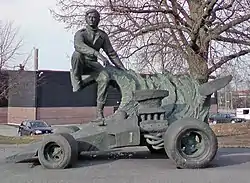
Peterson competed in 123 Grand Prix races during his career, winning ten of them.
At his funeral, the pallbearers included Åke Strandberg, James Hunt, Jody Scheckter, John Watson, Emerson Fittipaldi, Gunnar Nilsson and Niki Lauda.[14][24]
Legacy
Arrows driver Riccardo Patrese was blamed by several members of the Grand Prix Drivers' Association with being a primary cause of the first lap wreck at the Italian Grand Prix. He was banned from competition for one race, from the 1978 United States Grand Prix.
In 1979, George Harrison paid tribute to Peterson with a song and music video called "Faster".
The circumstances of Peterson's death were prosecuted in an Italian criminal court. Driver Riccardo Patrese and race director Gianni Restilli were both charged with roles; Patrese, for manslaughter because of an unsafe maneuver on track which was considered to be a primary cause of the wreck, and Restilli, as contributing to Peterson's death by starting the race with a premature start signal. Both were cleared of criminal charges on 28 October 1981.[25]
Peterson's widow Barbro (née Edwardsson) never got over his death and committed suicide on 19 December 1987. She was buried alongside Ronnie in the Peterson family grave in Örebro.[26] She and Ronnie had a daughter named Nina Louise (named after Jochen Rindt's wife) who was born in November 1975.[26][27]
There is a statue of Peterson in Örebro (59.26193°N 15.23812°E) by Richard Brixel. The official Ronnie Peterson museum was officially opened by Ronnie's daughter, Nina Kennedy, in Örebro on 31 May 2008. The museum closed in October 2009 because it was unable to secure further government funding.[28]
Superswede: A film about Ronnie Peterson (2017), directed by Henrik Jansson-Schweizer, with the participation of Mario Andretti, Emerson Fittipaldi, Nina Kennedy, and Niki Lauda, is available on YouTube, as are several other short tributes.
During the 2014 Monaco Grand Prix fellow Swedish racing driver Marcus Ericsson wore a special helmet in tribute to Peterson which was modeled on Peterson's.
In 2016, in an academic paper that reported a mathematical modeling study that assessed the relative influence of driver and machine, Peterson was ranked the 21st best Formula One driver of all time.[29]
Racing record
Career summary
‡ Graded drivers not eligible for European Formula Two Championship points
Complete European Formula Two Championship results
(key) (Races in bold indicate pole position; races in italics indicate fastest lap)
| Year | Entrant | Chassis | Engine | 1 | 2 | 3 | 4 | 5 | 6 | 7 | 8 | 9 | 10 | 11 | 12 | 13 | 14 | 15 | 16 | 17 | Pos. | Pts |
|---|---|---|---|---|---|---|---|---|---|---|---|---|---|---|---|---|---|---|---|---|---|---|
| 1970 | Malcolm Guthrie Racing | March 702 | Ford | THR DNS |
HOC Ret |
BAR Ret |
ROU 6 |
PER | TUL 5 |
IMO 4 |
HOC 3 |
4th | 14 | |||||||||
| 1971 | March Engineering | March 712M | Ford | HOC Ret |
THR 2 |
NÜR Ret |
JAR Ret |
PAL 3 |
ROU 1 |
MAN 1 |
TUL 1 |
ALB 6 |
VAL 1 |
VAL | 1st | 54 | ||||||
| 1972 | March Engineering | March 722 | Ford | MAL Ret |
THR 1 |
HOC | PAU | PAL | HOC 3 |
ROU | ÖST | IMO | MAN Ret |
PER | SAL Ret |
ALB | HOC 3 |
NC | 0‡ | |||
| 1973 | Team Lotus | Lotus 74 | Ford | MAL | HOC | THR | NÜR | PAU | KIN | NIV Ret |
HOC | ROU DNS |
MNZ | MAN | KAR 5 |
PER 7 |
SAL | NOR | ALB DSQ |
VAL Ret |
NC | 0‡ |
| 1974 | March Racing Team | March 742 | BMW | BAR | HOC | PAU | SAL | HOC | MUG | KAR 1 |
PER | HOC | VAL | NC | 0‡ | |||||||
| 1975 | Project 3 Racing | March 752 | BMW | EST | THR Ret |
HOC | NÜR | PAU | HOC | SAL | ROU | MUG | PER | SIL | ZOL | NOG | VAL | NC | 0 | |||
| 1976 | March Engineering | March 762 | BMW | HOC Ret |
THR | VAL | SAL | PAU | HOC | ROU | MUG | PER | EST | NOG | HOC | NC | 0 |
‡ Graded drivers not eligible for European Formula Two Championship points
Complete Formula One World Championship results
(key) (races in bold indicate pole position; races in italics indicate fastest lap)
Non-Championship Formula One results
(key) (races in bold indicate pole position; races in italics indicate fastest lap) (Races in italics indicate fastest lap)
| Year | Entrant | Chassis | Engine | 1 | 2 | 3 | 4 | 5 | 6 | 7 | 8 |
|---|---|---|---|---|---|---|---|---|---|---|---|
| 1971 | Frank Williams Racing Cars | March 711 | Ford Cosworth DFV 3.0 V8 | ARG | ROC Ret |
||||||
| STP March Racing Team | QUE 18 |
SPR | RIN 2 |
OUL | VIC 16 | ||||||
| Alfa Romeo T33 3.0 V8 | INT Ret |
||||||||||
| 1972 | STP March Racing Team | March 721X | Ford Cosworth DFV 3.0 V8 | ROC 13 |
OUL Ret |
REP | |||||
| March 721 | BRA 2 |
INT | |||||||||
| March 721G | VIC 8 |
||||||||||
| 1973 | John Player Team Lotus | Lotus 72E | Ford Cosworth DFV 3.0 V8 | ROC Ret |
INT 2 |
||||||
| 1974 | John Player Team Lotus | Lotus 76 | Ford Cosworth DFV 3.0 V8 | PRE | ROC | INT Ret |
|||||
| 1975 | John Player Team Lotus | Lotus 72E | Ford Cosworth DFV 3.0 V8 | ROC 3 |
INT DNS |
SUI 4 |
|||||
| 1977 | Elf Team Tyrrell | Tyrrell P34 | Ford Cosworth DFV 3.0 V8 | ROC 10 |
|||||||
| 1978 | John Player Team Lotus | Lotus 78 | Ford Cosworth DFV 3.0 V8 | INT Ret |
|||||||
24 Hours of Le Mans results
| Year | Team | Co-Drivers | Car | Class | Laps | Pos. | Class Pos. |
|---|---|---|---|---|---|---|---|
| 1970 | Ferrari 512S | S 5.0 |
39 | DNF | DNF | ||
Source:[30] | |||||||
References
Journals
- Henry, Alan (October 2008). "My Mate Ronnie". Motor Sport. 48 (10): 58–64.
Internet
- Nyberg, R. & Diepraam, M. 2000. Super Swede. 8W, January 2000.
Citations
- "Formula 1's Greatest Drivers – Ronnie Peterson". autosport.com.
- "Forgotten Heroes of Formula One: Ronnie Peterson". bleacherreport. Retrieved 1 August 2008.
- "Ronnie Peterson Profile". grandprix.com.
- Lawrence, Mike (1989) The Story of March; Four guys and a telephone Aston Publishing Ltd. p. 36 ISBN 0-946627-24-X
- "8W – Who? – Ronnie Peterson". 8W Forix.
- "Ronnie Peterson-a future champion". The Glasgow Herald. 31 October 1973. p. 4.
- Thompson, Andrew; Howard, Tony (December 1975). "Zak the giant killer". SA Motor. Cape Town, South Africa: Scott Publications: 33–37.
- "Tyrrell P34 • STATS F1". www.statsf1.com. Retrieved 22 January 2019.
- "Major incidents of fan deaths". Tampa Bay Times. 11 June 2005. Retrieved 22 March 2013.
- Soulsby, Chris (15 January 2019). "Ronnie Peterson: The Champion That Never Was". Last Word on Motor Sport. Retrieved 22 January 2019.
- "1978 • STATS F1". www.statsf1.com. Retrieved 22 January 2019.
- "Lotus - One-two • STATS F1". www.statsf1.com. Retrieved 22 January 2019.
- "Do Champions Need Team Orders?". atlasf1.autosport.com. Retrieved 22 January 2019.
- "30 years on: remembering Ronnie Peterson". formula1.com. Retrieved 11 September 2008.
- "Ronnie Peterson: Driver Profile". ESPN.
- AP (12 September 1978). "Peterson's Death Triggers Investigation". The Kokomo Tribune. Retrieved 30 May 2019 – via Newspapers.com.
- "Driver Dies After Crash". Pittsburgh Post-Gazette. 12 September 1978. p. 18.
- "Ronnie Peterson dies from crash". The Morning Record and Journal. 12 September 1978. p. 10.
- "The Death of Ronnie Peterson: What Really Happened at Monza in 1978". atlasf1.
- "The operation". www.ronniepeterson.se. Archived from the original on 25 September 2013. Retrieved 22 October 2017.
- "The Death notice". www.ronniepeterson.se. Retrieved 22 October 2017.
- [email protected], The Motorsport Memorial Team. "Motorsport Memorial -". www.motorsportmemorial.org. Retrieved 22 October 2017.
- Larry Schwartz. "Super Mario had speed to burn". ESPN. Retrieved 12 July 2007.
- "The Funeral". www.ronniepeterson.se. Archived from the original on 19 June 2013. Retrieved 24 August 2013.
- "Monza Defendants Cleared in Fatal Crash". The Tampa Tribune. 29 October 1981. Retrieved 30 May 2019 – via Newspapers.com.
- "Biography". www.ronniepeterson.se. Archived from the original on 7 June 2008. Retrieved 22 October 2017.
- Formula 1 complete – all access F1 – Peterson, Ronnie Archived 10 July 2011 at the Wayback Machine
- "Archived copy" (in Swedish). Archived from the original on 11 August 2010. Retrieved 24 August 2013.CS1 maint: archived copy as title (link)
- "The Top 50 F1 drivers of all time, regardless of what they were driving". New Atlas. 12 May 2016. Retrieved 12 March 2020.
- "Ronnie Peterson, Sweden". racingsportscars.com. Retrieved 13 September 2017.
External links
| Sporting positions | ||
|---|---|---|
| Preceded by Reine Wisell |
Swedish Formula Three Champion 1968–1969 |
Succeeded by Torsten Palm |
| Preceded by Jean-Pierre Jaussaud |
Monaco Formula Three Race Winner 1969 |
Succeeded by Tony Trimmer |
| Preceded by Clay Regazzoni |
European Formula Two Champion 1971 |
Succeeded by Mike Hailwood |
| Preceded by Brian McGuire |
Formula One fatal accidents 10 September 1978 (Date of accident) 11 September 1978 (Date of death) |
Succeeded by Patrick Depailler |